Modern "bus" for the infantry
ISRAEL. HEAVY-DUTY ACHZARIT.
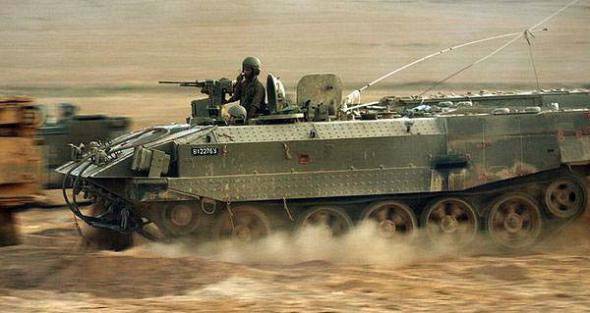
Creation
A pioneer in the creation of heavy armored personnel carriers is Israel. This Israeli engineers pushed the experience of the war in Lebanon in 1982, most of the battles which was conducted in urban environments. If the American-made МХNUMXА60 tanks, which are in service with the Israel Defense Forces (IDF), were to some extent defended by the dynamic defense (MD) used for the first time, the American M1 armored personnel carriers became easy targets for Arab grenade launchers. On the Israeli tanks "Merkava" Mk113 dynamic protection was not installed. It was believed that the level of protection and survivability on the battlefield of this machine is already quite high. And in vain. The Merkava from the fire of the grenade launchers were burning, as were all the other tanks. But still the armored personnel carriers and the infantry sitting in them got the most.
Having studied the experience of that war, the SOI leadership developed a tactical and technical assignment for the development of a heavy armored personnel carrier, which later received the name "Achzarit". In accordance with them, this was supposed to be a highly protected machine capable of operating in local conditions in conjunction with the main Merkava tanks. The idea of creating such a machine was prompted by the successful use in urban areas as a means of delivering infantry to the battlefield of an engineering PuMA detachment machine, made on the chassis of the main tank Centurion.
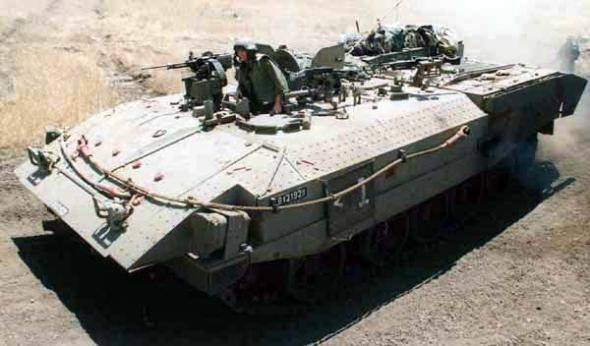
The development of heavy armored personnel carriers in Israel initially envisaged the use of a variety of chassis, including the chassis of the Merkava and Centurion tanks. The first prototypes of the Achzarit BTR were built in 1987. Later, the option of creating a vehicle on the chassis of the T-55 tank, which the Israeli army took in large quantities as trophies during the Arab-Israeli wars and then for several years, was worked out. reinstated for pd
The tests of the prototypes of the Achzarit machines based on the T-55 showed some advantages over the previously worked out variants and especially the lower cost of the machine. Their adoption by the Israel Defense Forces as a heavy armored personnel carrier and the beginning of their mass production took place in 1988. Production of heavy Achzarit armored personnel carriers was carried out in the workshops of the IDF and at the Military Plant located in Tel-Aviv.
According to various estimates, about 400-500 of such vehicles are currently in the Israeli armed forces.
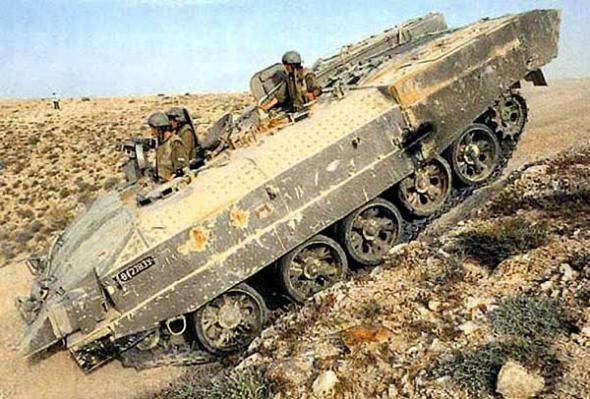
Machine design
When rebuilding a T-55 tank into a heavy BTR, its chassis is completely disassembled and then restored, but with some modifications. The turret of the tank is also dismantled and an additional superstructure is brewed on the body of the machine in the habitable compartment, which forms the control compartment and the troop compartment. The engine-transmission compartment is located in the stern of the car, but instead of the standard engine and transmission, it is installed the power plant of the Israeli company NIMDA, which has a slightly smaller height and a more powerful engine.
An additional reservation developed in Israel is installed on the car case, which, according to the developers, provides this car with the best protection among all the available cars in the world of this type.
In the habitable compartment of the car can accommodate up to 10 people, including a crew consisting of three people: the commander of the machine, the driver and the gunner of the machine gun. Place the driver left front left. Above it there is a separate hatch, the lid of which opens to the left. Four periscopic daytime observation devices are installed in front of the hatch, one of which in the center can be replaced by a passive night observation device for night driving.
The car commander is located to the right of the driver and has a rotating periscope daytime surveillance device mounted on the roof of the car and a square hatch, the lid of which opens back. On the right, in front of the machine, there is a machine gunner, who manages the installation of the RAFAEL Overhead Weapon Station with the M7,62 240-mm machine gun mounted on it. The machine gun has a stabilization in two planes and is induced by remote control from inside the machine. The aiming set of the installation is equipped with day and night thermal sights.
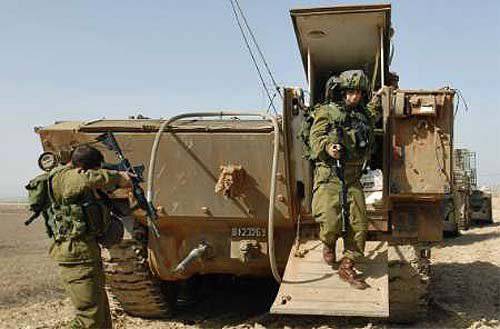
In addition to the remotely controlled machine gun on the Achzarit BTR, there are also three additional 7,62-mm machine guns mounted on pivot rigs: one on the hatch of the vehicle commander and two in the rear of the troop compartment of the vehicle. For firing from these machine guns it is necessary to open manhole covers and protrude out of them.
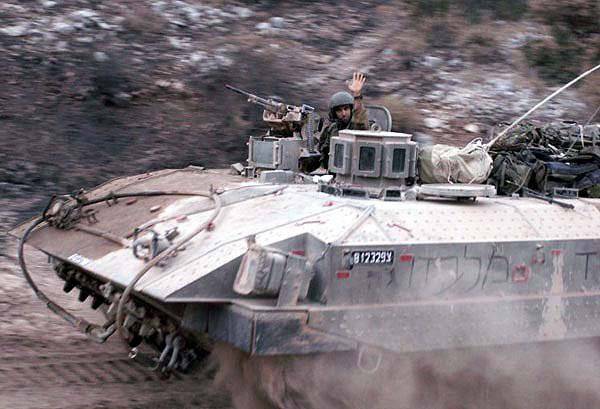
Seven infantrymen are placed in the rear of the manned compartment of the vehicle: three on the continuous bench seat on the left side, three on the individual folding seats on the right, and one in the center at the rear of the troop compartment.
The driver, commander and gunner of the machine-gun installation each have their own hatch. The commander's manhole cover can be opened in half for surveillance. Behind the hatches of the crew members there are two additional hatches: one in the center of the troop compartment and the other a little to the left and behind.
Established diesel engine B-55 and manual transmission were removed and installed powerplant company NIMDA. This unusual and extremely compact power plant made it possible to make an exit for the assault on the stern of the car on the right side, closing with an armored hinged door using a hydraulic drive. The lower part of it leans down and serves as a ladder, and the upper part opens upwards. The aft exit for the landing force was carried out without changing the configuration of the vehicle hull. In addition, infantry can land and disembark through hatches in the roof of the habitable compartment.
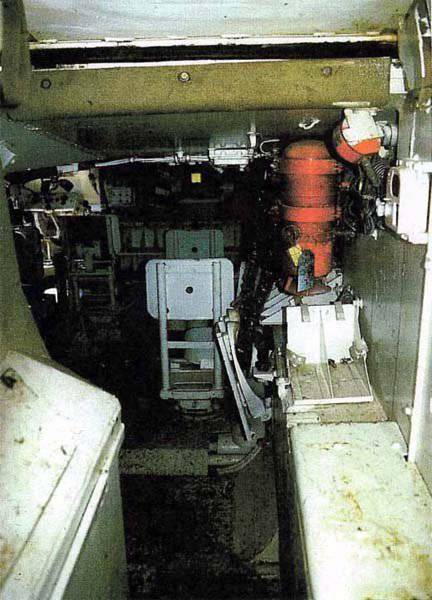
The power plant combines various units, the main of which are identical to those used on the modernized in Israel version of the Soviet T-55 tank, which received the name "Samovar", as well as on the American 155-mm SAU M109. Both of these sample machines are used in large quantities in the Israel Defense Forces.
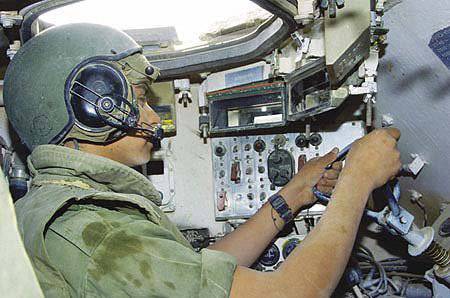
The power plant of the Achzarit Mk1 BTR, supplied by the Israeli company NIMDA, consists of the American two-stroke diesel engine of liquid cooling Detroit Diesel 8V-71 TTA, developing the power of the 650 hp. The engine is installed across the body of the car and is connected to the hydrodynamic automatic transmission Allison XTG-411-4, also produced in the United States.
Air intake by the engine is carried out either through the combat compartment or through the engine compartment. In both cases, the air enters initially through a pre-filter with a dust blower, and then through a paper air cleaner, similar to those installed on cars.
The chassis of the T-55 tank, consisting of five road wheels, a driving wheel at the rear and a guide wheel on the front of each side, was also upgraded. The suspension rollers of the road wheels are equipped with new torsion shafts, which allowed to increase the dynamic course of the roller, and the first and last suspension nodes are equipped with hydraulic stops from Israel Aircraft Industries, which are also used on Merkava tanks. Such a modernization of the suspension provides the car with better mobility over rough terrain and allows it to operate in conjunction with the main tanks.

The combat mass of the Achzarit BTR has increased to 44 tons compared to 36 tons in T-55 tanks. As already mentioned, the T-55 tower, when reworked in the Achzarit BTR, is dismantled. The main difference in mass between the mass of the Achzarit BTR, having 44 t and the mass of T-55 hull in 27 t, is explained by the installation of additional armor protection to increase the survivability of the vehicle on the battlefield. The total height on the roof of the enclosure is approximately 2 m, and the width of the machine is 3,64 m.
On both sides of the hull, six CL-303Q smoke grenade launchers manufactured by Israel Military Industries were installed in the front part of it. Such grenade launchers were originally mounted on Israeli Centurion, M48 / M60 and Merkava tanks. They can shoot different types of grenades in the direction of the car.
The standard equipment of the Achzarit BTR includes the Spectronix fire detection and extinguishing system, a system for collective protection against weapons of mass destruction and smoke-relief equipment for setting smoke screens using the fuel injection principle in the engine exhaust manifold located on the left side of the body.

Currently, the IDF has a version of the heavy Achzarit Mk2 armored personnel carrier. This machine has a new power plant, also supplied by the Israeli company NIMDA. It includes the American diesel engine “Detroit Diesel” 8V-92 TA, which develops the power of the 850 hp, combined with the American automatic transmission “Allison” XTG-411-5. This power plant provides the machine with a higher power density and better acceleration characteristics. To date, the model "Achzarit" Mk2 is still the latest example of this heavy armored personnel carrier.
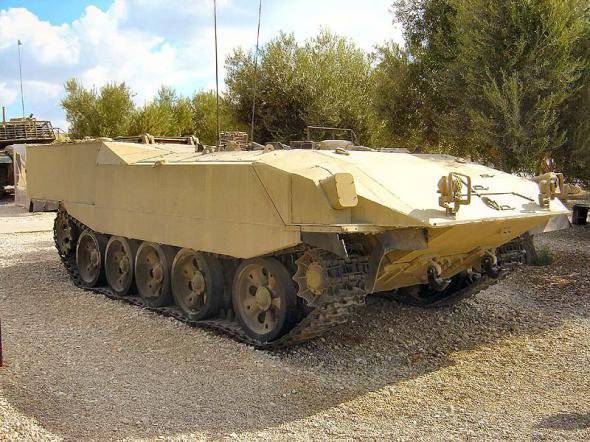
In addition, on the basis of the heavy armored personnel carrier “Achzarit”, a version of the command and staff vehicle was created, which differs from the standard type of armored personnel carrier by the absence of machine guns on the roof of the vehicle and the equipment of additional radio stations to perform specialized control functions.
The main tactical and technical characteristics of the heavy Bch Achzarit
Combat weight, t - 44
Crew + landing party, people - 3 + 7
Maximum speed, km / h - 50
Engine
- brand - "Detroit Diesel" 8V-92 TA
- power, hp - 850
Armament:
- basic - 7,62-mm machine gun M240 with remote control
- additional - two 7,62-mm machine guns FN MAG
Armor Protection - Provides RPG Protection
RUSSIA. HEAVY ARMORED RESPONSE BTR-T.
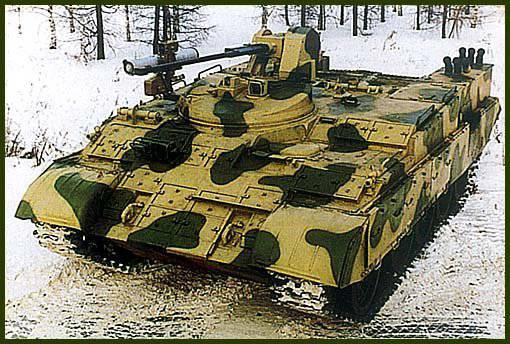
Creation
To provide a higher level of protection for infantry troops of motorized rifle subunits operating together with tanks, a prototype of a new heavy armored personnel carrier, designated BTR-T (heavy armored personnel carrier), was developed in Russia on the basis of the T-55 tank chassis of the Omsk Transport Engineering Design Bureau (KBTM). For the first time it was demonstrated at the exhibition of arms VTTV-97 in Omsk in 1997.
The construction of the heavy armored personnel carrier BTR-T was carried out at the Omsk Transport Engineering Plant (Omsktransmash).
According to the designers, a large number of T-55 tanks available in Russia, which can be converted into BTR-T, would provide the army with relatively inexpensive and highly protected combat vehicles for infantry. According to some sources, the export value of the BTR-T is 600 thousand USD, respectively, and the re-equipment of the T-55 tank in the BTR-T is much cheaper.
Design
The new heavy armored personnel carrier BTR-T is based on the chassis of the T-55 tank, from which the turret was removed and the hull was raised to provide additional space for the crew and landing force in front of the vehicle and the engine compartment stored in the rear part of the vehicle.
The crew of the car consists of two people. The driver is in front of the same place and the commander-gunner is in the tower. In the troop compartment can be transported five fully equipped infantrymen.
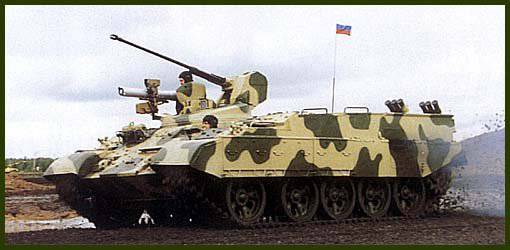
For landing and landing assault there are hatches in the roof: front right and behind the tower. Since the roof of the habitable compartment above the level of the roof of the hull, two more hatches were made at the rear of the wheelhouse. The covers of these hatches open upwards and have built-in prism blocks for observation. With the same purpose, the troop compartment is also equipped with periscopic instruments.
The BTR-T heavy armored personnel carrier has a combat mass of 38,5 tons (compared to 36 tons of a standard T-55 tank). If we consider that the body of the BTR-T has a mass of 27 T, then it becomes clear that the main part of the mass of the BTR-T that was increased by more than 10 tons went to strengthen the armor protection of the vehicle.
Frontal armor parts and sides are equipped with the latest generation Kontakt-5 dynamic protection package, which provides a high level of protection not only against cumulative, but also against armor-piercing sub-caliber ammunition. Similar DZ is used on modern Russian tanks T-80U and T-90С.
In addition, the BTR-T reinforced the bottom of the hull to increase the survivability of the machine when undermining anti-tank mines. This is provided by additional reservation of the bottom, which is welded to it with a gap, forming an air gap between the additional armor and the bottom itself, which significantly reduces the impact of the blast wave during a blast on a mine.
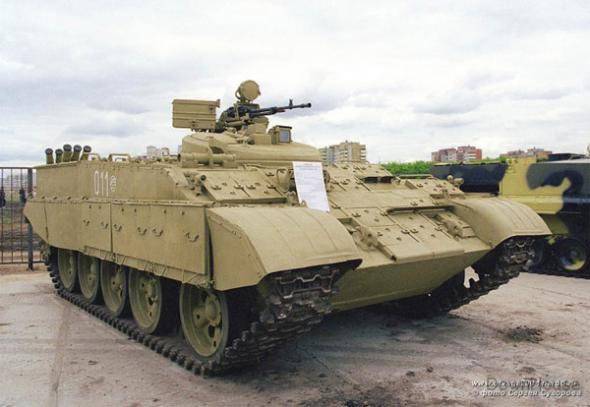
In order to compensate for the increased mass and maintain mobility at the same level, not lower than it was on the T-55 tank, a more powerful B-46-6 engine was installed on the machine, which develops the power of the 780 hp. The transmission of the car has also been improved.
In front of the case, a low-profile turret is installed, on which elements of the weapons complex are mounted.
The armament complex on the BTR-T may have a different composition, since it is implemented in the form of various modules that can be installed on the machine depending on its purpose or customer requirements.
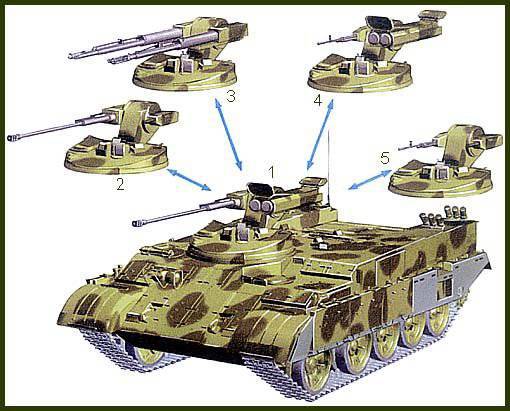
The following options for weapons BTR-T:
1. 30-mm automatic gun 2А42 and two PU-ATGM "Competition";
2. 30-mm automatic gun 2А42 and 30-mm automatic grenade launcher AG-17;
3. Two double-barreled 30-mm machine gun 2А38;
4. 12,7-mm machine gun NSVT-12,7 "Rock" (or "Kord") and two PU ATGM "Competition";
5. 12,7-mm machine gun NSVT-12,7 "Rock" (or "cord") and 30-mm automatic grenade launcher AG-17.
In addition, in addition to the use in the composition of the modules with a complex of weapons weapons Russian development and production, they can also be installed and samples of weapons of Western production.
Like many Russian-made armored combat vehicles, the BTR-T has a thermo-smoke equipment for the installation of smoke screens through the injection of fuel into the exhaust path. In addition, there are four blocks (three launchers each) for launching smoke or aerosol grenades. The placement of smoke (aerosol) air curtains from these blocks is carried out ahead of the machine.
Main tactical and technical characteristics of heavy BTR-T
Combat weight, t - 38,5
Crew + landing party, people - 2 + 5
Maximum speed, km / h - 50
Engine
- brand - B-46-6
- power, hp - 780
Armament (option):
- basic - 30-mm automatic gun 2А42
- additional - 7,62-mm PKT twin machine gun
- a complex of guided weapons - PU PTRK "Competition-M"
Ammunition, (shots):
- for 30-mm guns 2А42 - 200
- for PKT machine gun - 2000
- for ATGM - 3
Armored protection - provides protection against RPG and ATGM
INDIA. HEAVY BOOKED TRANSPORTER TBHA.
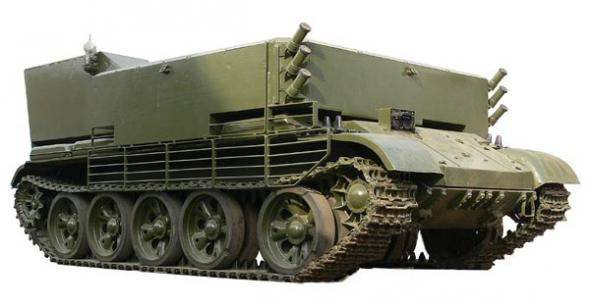
In India, which also has a large number of Soviet-built T-55 tanks, also decided to turn to the experience of building heavy armored personnel carriers. Not without the influence of Israel, they also took the good old T-55 tank, removed the turret, welded multi-layer thick armor on the hull, and was ready. So it turned out the Indian heavy armored personnel carrier TBHA - T-55 Based Heavy APC (APC - armored personnel carrier - our armored carrier).
The spacious "saloon" of the car can accommodate up to 11 people (along with two crew members - a driver and commander, he is also the gunner of the machine-gun installation). I must say, the "salon" is equipped comfortably, you can stand to its full height, inside it is trimmed with carpet.
To monitor the surrounding terrain, the commander uses the sighting system of a remote-controlled machine-gun installation, which stands on the roof of the vehicle. The image from the combined sight is displayed on the LCD screen. The unit is equipped with an 12,7-mm machine gun, the NSVT-12,7 “Rock” type, stabilized in two planes, which allows for targeted fire from a machine gun on the move. According to the developers, "the armor of the cabin is able to withstand a grenade hit from RPG-7 from all sides," which looks very doubtful. True, the developers of the RPG-7 declare something else: "To date, there is no sample of armored vehicles whose armor has not been pierced by the RPG-7 grenade."
The transmission and engine of the T-55 tank were replaced by the Israeli power plant of the NIMDA company, just as the Israelis did on the Achzarit Mk2 APC. It is a bit more compact than the previous one, combines American 850-strong diesel “Detroit Diesel” 8V-92 and automatic transmission “Allison” XTG-411-5. Such is the Israeli assembly of American components. The new power plant made it possible to make an exit for the transported infantrymen on the stern of the car. When you open it, its armored door also serves as a ladder for getting into and out of the car.
Naturally, the TBHA is equipped with collective protection systems for weapons of mass destruction, fire extinguishing, air conditioning and smoke screens. At the request of the customer, it can be installed additional weapons systems, surveillance, etc.
The disadvantage of this version of the heavy armored personnel carrier is the impossibility of firing from the personal weapons of the assault force inside the vehicle and the presence of only one machine gun. So only two people will be involved in the business - the driver and the commander, the rest will simply ride along the indicated route by passengers.
The main tactical and technical characteristics of the heavy armored personnel carrier TBHA
Combat weight, t - about 45
Crew + landing party, people - 2 + 9
Maximum speed, km / h - 50
Engine
- brand - Detroit Diesel 8V-92 TA
- power, hp - 850
Armament - 12,7-mm machine gun NSVT-12,7 "Rock" with remote control
Sighting system - combined with optical and thermal channels, with remote control
Armor Protection - Provides RPG Protection
JORDAN. HEAVY BTR AB14 TEMSAH.
[Center]
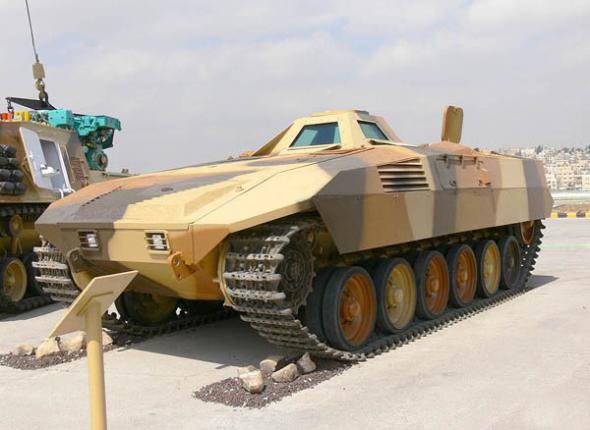
If another two decades ago the construction and even modernization of armored vehicles was the fate of only a small number of states with a high level of industry, then recently there has been an increase in the producers of such equipment. The Hashemite Kingdom of Jordan has recently joined them. For almost the last ten years, the Jordanian company KADDB (King Abdullah II Design and Development Bureau) has presented its developments in the field of armored vehicles at international arms exhibitions.
With respect to tanks, KADDB was engaged in their modernization, but with respect to heavy combat vehicles for infantry, it was able to present a new development. However, this is understandable, heavy armored personnel carriers and infantry fighting vehicles were born in the Middle East, however, they first appeared on the other side of the Jordan. Due to certain circumstances, the Arab countries do not learn from Israeli experience and do not invite specialists from this country. In addition, there are no tanks built in Jordan of Soviet construction. With the participation of the Mechanology Design Bureau (MDB) from South Africa, the US General Dynamics Land Systems and the Jordanian CLS, a highly-protected combat vehicle for infantry AB14 Temsah was created. It is designed on the basis of the chassis of the tank "Centurion". However, it had to be significantly re-arranged, so we can say that “Temsah” is already a purely Jordanian brainchild.
Layout
The layout of the machine is made with the front of the power plant. In other words, the hull of the tank "Centurion" was deployed at 180 degrees. In the power plant of the machine used American diesel engine AVDS 1790, power 950 hp, which is also used when upgrading tanks M60A1 in Jordan. Transmission automatic CD 1000, has two gears forward and one reverse. Suspension armored personnel carrier hydropneumatic balancing. The dynamic course of the roller is + 350 and -100 mm.
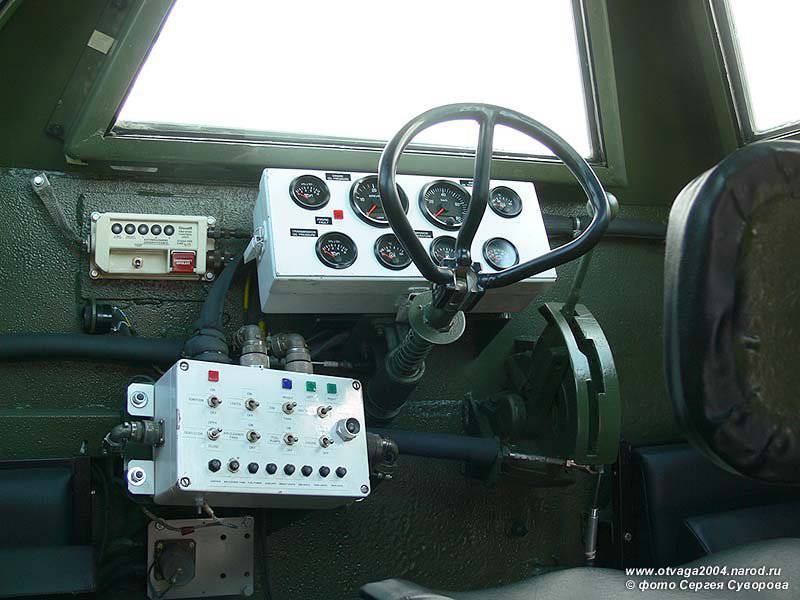
Reservation of the car is significantly enhanced compared with the base chassis of the tank "Centurion". It provides protection for the crew inside and inside the vehicle, not only from small arms fire, but also from artillery ammunition. The hull design provides for the installation of dynamic protection that will make a heavy armored personnel carrier more resilient in the face of exposure to fire with anti-tank grenade launchers. However, it is not reported whose development formed the basis of the proposed dynamic protection. In addition, the developers believe that the front location of the power plant increases the survival of the crew of the car on the battlefield during the shelling in frontal projections. The body of the BTR has a relatively small height, just over two meters, which also, in the opinion of the creators of the vehicle, increases its survivability on the battlefield. Superstructures of the hull - towers with different variants of armament complexes - are uninhabited and remotely controlled from the hull of the vehicle.
Recently, the KADDB company presented another sample of the heavy Temsah BTR without any weapon systems at all. On the roof of the car body there is a small superstructure which has relatively large armored glass on all sides, providing good visibility from the car. If necessary, these glasses are closed armored plates in which there are gaps for observation.
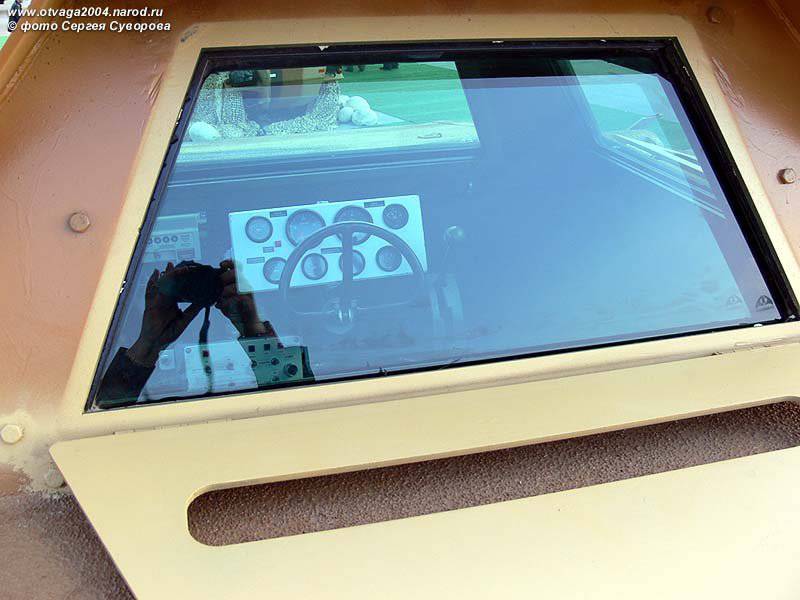
The crew of the armored personnel carrier "Temsah" consists of two people: a driver and commander, he is also an operator of the armament complex. The assault unit of the BMP is designed to accommodate 10 infantrymen in full gear. It should be noted, it is quite spacious and has a length of 3350 mm, width 1770 mm and height 1455 mm.
Loopholes for firing from personal weapons in the car are not equipped. However, television cameras can be installed to monitor the terrain of the landing force, and inside the troop compartment of the 4 liquid crystal television monitor. Infantrymen in the car are located along the sides, with his back to them. For landing and landing troops machine is equipped with a folding ramp in the aft with a mechanical drive. There are also hatches in the back of the roof of the troop compartment. Their number, depending on the version of the machine, can vary from one to six.
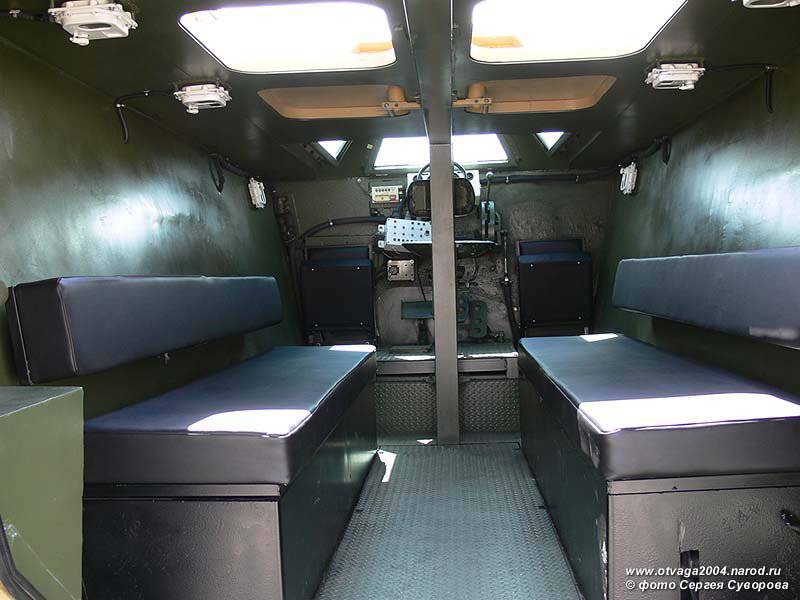
Inside the car, under the assault seats, pallets are installed for dry rations and water for all people in the car. According to the developers, the water and food supplies allow the machine to operate autonomously for 48 hours.
options
Armament machines may be different. So far, two variants of the Temsah BTR were demonstrated: in one, the armament complex used a large-caliber machine gun mounted in a remote-controlled tower module, and two INGWE anti-tank guided missiles, manufactured in South Africa. In another version, with an automatic 20-mm cannon, a machine gun paired with it, and an INGWE ATGM anti-tank missile system, also installed in a remote-controlled tower module.
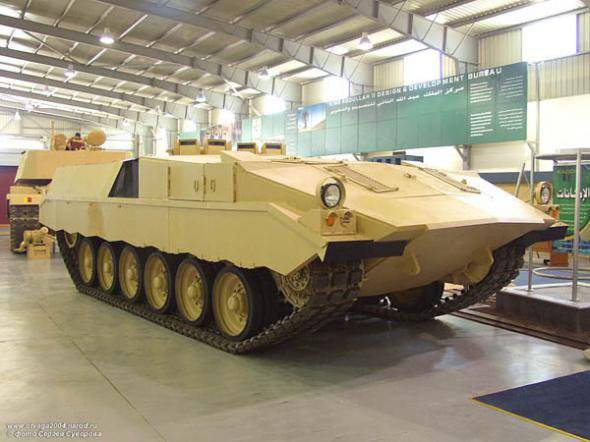
Armament "Temsah" stabilized in two planes. The rate of fire of an automatic cannon is 200 shots per minute, its ammunition - 300 shells, of which only 150 are ready for use. The rest are laid in the car and they need to be charged, after using up the tape with ammunition on the turret. The target range of the cannon is 2000 m. The fire from the cannon can be fired by single shots or bursts.
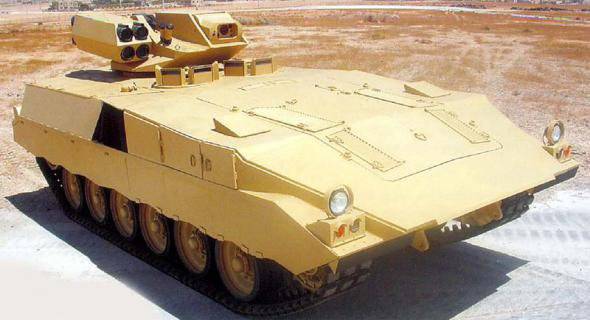
The 7,62-mm machine gun M240, paired with a cannon, is a tank variant of the famous Belgian FN MAG. Sighting range of shooting - 1200 m, 2600 ammunition ammunition, of which only 600 is ready to use. The remaining 2000 pcs. laid in laying inside the troop compartment of the machine. ATGM ammunition is 4 missiles - only those that are in launchers. INGWE ATGM firing range from 500 to 5000 m.
Smoke grenade launchers are mounted on the tower module for the installation of smoke screens.
Pointing weapons is carried out remotely from the body of the machine. Monitoring the battlefield and aiming is carried out on the LCD television monitor installed in the workplace of the commander of the machine. The elevation angles of the weapon range from -8 to + 40 degrees, which, in my opinion, is not quite sufficient, since the machine is designed to operate in the city and mountainous terrain, which is more than enough in Jordan.
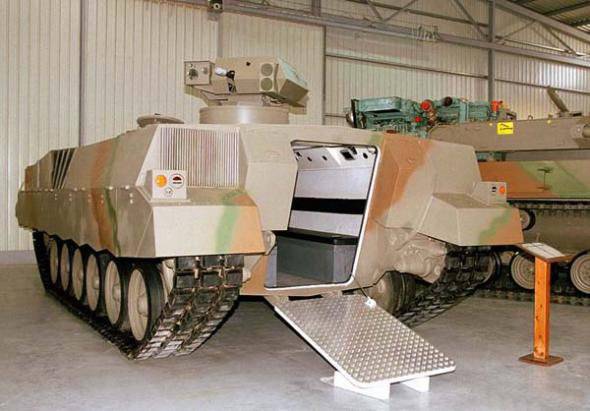
As standard, the machine is equipped with collective protection systems, air conditioning and fire protection system.
The main tactical and technical characteristics of the heavy armored personnel carrier "Temsah"
Combat weight, t - 49,5
Crew + landing party, people - 2 + 10
Sizes, mm:
- length - 7962
- width - 3766
- height on the roof of the case - 2080
- clearance - 500
Engine
- brand - AVDS 1790
- power, hp - 950
Specific power, hp / t - 19,2
Permissible payload, t - 4
Armament (option):
- main - 20-mm automatic gun
- additional - 7,62-mm machine gun M240
- guided weapons complex - INGWE ATGM
Ammunition, (shots):
- for 20-mm guns - 150 + 150
- for the machine gun M240 - 600 + 2000
- for ATGM - 4
Fuel stock, l - 950
Armor Protection - Provides RPG Protection
*****
Thus, there is a worldwide tendency to use obsolete types of tanks (mainly “Centurion” and T-55) for further service as heavy armored personnel carriers. At the same time, such BTRs are significantly lower in the cost of new combat vehicles, which allows many armies to have in their composition a sufficient number of such BTRs. The main purpose of heavy armored personnel carriers is to transport and support infantry units with fire during independent or joint operations with tank units in special conditions (combat in mountainous and wooded areas, in the city, etc.). Powerful booking of heavy armored personnel carriers makes it possible to reduce losses both of personnel and of the vehicles themselves from the fire of large-caliber rifles and machine guns, small-caliber automatic cannons, and also from detonation of mines.
At the same time, for the acquisition of mobile forces, light combat vehicles will be used, that is, conventional infantry fighting vehicles and armored personnel carriers, whose mass does not exceed 30 t.
Options are provided for using the Temsah BTR chassis as a tracked armored medical vehicle, a command post, as well as for a base for self-propelled guns and mortars.
Information